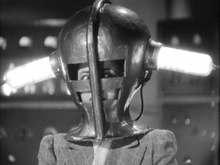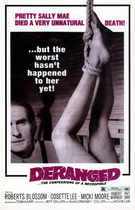Our editor-in-chief Nate Yapp is proud to have contributed to the new book Hidden Horror: A Celebration of 101 Underrated and Overlooked Fright Flicks, edited by Aaron Christensen. Another contributors include Anthony Timpone, B.J. Colangelo, Dave Alexander, Classic-Horror.com's own Robert C. Ring and John W. Bowen. Pick up a copy today from Amazon.com!
The Devil Commands (1941)
It's hard to imagine the history of film or literature without mad scientists. We'd never have encountered Victor Frankenstein, Dr. Jekyll, Dr. Moreau, or a host of other colorful, enduring characters that have captivated our souls for decades. The Devil Commands is a testament to that prototype's allure.
As a popular narrative trope, mad scientist stories appear, on the surface, simple. Enter your typical mad scientist. He's crazy and consequently initiates a firestorm of chaos. Hell breaks loose, innocents die, he's hunted down and eventually caught, punished, or exterminated. However, underlying these conventions lurk crucial thematic and generic questions that defy cursory analysis. Is the scientist's "science" scientific? What drives him mad: his inherently evil intentions or the science itself and his quest for knowledge? Is the chaos intentional or accidental? Is the chaos a result of the scientist or his science?
If his madness is the product of his megalomaniac intentions, and his wildly dangerous experimentation is the result of these distorted perspectives, the film leans more toward horror because the terror is human-induced, and the chaos is intentional, a means to a more maniacal end. Conversely, if he's not "mad" but a rigorous intellectual, and his wildly dangerous experimentation is more the result of chance, error, scientific rigor, or unexplained phenomenon that nobody could have predicted, the film leans more toward science fiction because the terror is science-induced, and the chaos is more accidental, a means to a more tragic ending. These are sometimes difficult distinctions to make, and the best mad scientist films often blur these lines, sometimes to their benefit, sometimes not.
Since it doesn't conveniently fit in either camp, The Devil Commands falls somewhere in the middle. To some, it's a confusing installment of this enduring trope because it never effectively establishes its scientist's madness. Dr. Julian Blair, played by the iconic Boris Karloff, is more sympathetic than evil, making the film more a sci-fi thriller than a horror film. However, others could argue it's also a provocative, complicated spin on the mad scientist theme because the protagonist's madness is caused by both his personal demons and his spirited pursuit of scientific knowledge, making it another engaging edition of this age-old horror subgenre.
Narrated through a voice-over by Anne Blair, daughter of Dr. Julian Blair, The Devil Commands begins with Anne wondering why so many people fear her professorial father. We quickly learn why: his attempts to record and chart the wavelengths of people's brain impulses become an obsession that transforms the respected researcher into a "mad" scientist. After Blair, the local university's Science Department Chair, reveals to colleagues his new methods of telepathic communication, his wife accidentally dies. As sadness overwhelms him, Blair uses his research to communicate with her. However, his experiments quickly backfire. The local sheriff visits him to address rumors concerning Blair that are circulating amongst the townsfolk. The sheriff recruits Blair's maid as a spy, but when she sneaks into Blair's lab, more chaos follows.
Oscar-nominated director and film-noir stalwart Edward Dmytryk brought a heavy reputation to the film. Although The Devil Commands appears early in his filmography, it's what happened after this film - between 1947 and 1952 - that's most intriguing. Dmytryk was one of the Hollywood 10: the group of filmmaking professionals who in 1947 was suspected of having Communist sympathies and was consequently blacklisted for refusing to testify about their political associations before the House Committee on Un-American Activities. Ironically, although The Devil Commands was released before Dmytryk's Red Scare troubles began, the film strikes related chords.
Blair's scholarly colleagues ostracize him because of his radical belief in telepathic communication, so he conducts his research in isolation. His laboratory is located outside town along its edges near the ocean, and his assistants operate in shadows like a sleeper cell of rejected occultists. Regret, remorse, and revenge are some of the emotions - along with public humiliation and mourning - that amplify the film's tone, drawing eerie parallels to the xenophobia that fueled McCarthyism a few years later.
As is often the case, Karloff himself is the film's brightest gem. The Devils Commands surfaced during a transitional period in his career: released well after he had established himself as one of horror's masters, it came shortly before he lumbered into television and occasionally became a parody of himself. Nevertheless, if there's one actor who can carry a film into respectability, it's Karloff. With his charming lisp and grandfatherly demeanor on full display, you'll want to invite Dr. Blair home for dinner.
However, unlike other horror classics such as Frankenstein and The Mummy, where Karloff's physical acting skills shone brightly while playing archetypal monsters, in The Devil Commands Karloff's character never becomes monstrous, so his acting prowess shines through his sympathetic humanity. In fact, his acting acumen - particularly his ability to convey empathy and emotion - is too convincing: his desire to reconnect with his deceased wife, and his decision to use his research as a vehicle for doing so, appear more the product of natural mourning than the greedy machinations of some monstrous, evil scientist. He fervently continues his research - against colleagues' wishes - because he believes it will consummate a new connection with his wife. Many people - given Blair's scientific background and the resources available to him - would easily succumb to a comparable degree of mourning. Is his situation tragic? Yes. But is his character evil? Well, not really...
However, the film's greatest strength is how it ambiguously portrays Blair's potential "madness". Although we sympathize greatly with Blair, we cannot overlook that the forgetful, absent-minded, scholarly Blair is too committed to science. Consequently, he'll use anyone in experiments, and the results are often catastrophic: his family members and assistants are usually in danger, and in some cases, they're either scarred or killed. And this is evident before his wife dies. For example, at one point, his wife describes herself as "Guinea Pig #1", and later, his daughter almost experiences the same fate. At one point a colleague in a heavy German accent says, "There are things human being have no 'vight' to know." However, Blair refuses to listen, and his scientific objectivity sinks deeper into depressed mourning, creating a toxic brew that uses science not to further mankind's knowledge, but to mollify his emotional trauma.
Nevertheless, although Blair's scientific obsessions are displayed before his wife's tragedy, we also cannot ignore the fact that he is generally a respected scientist, eager to further knowledge in his field. He has no intentions of harming anyone, although his telepathic communication does impose upon some taboo realms that his colleagues have reservations about. Although he's approaching some dangerous thresholds, prior to his wife's death, he's careful not to surpass them. Before her death, Blair is convinced there's "proof of life after death" and that the dead can speak with the living. He believes the human brain is the "most perfect sending and receiving mechanism on Earth, "and by communicating with the dead, we can "wipe out the horror" of death and shatter the veil that separates life from death. These are noble causes and provocative topics, and Blair's intentions for researching them are altruistic, but his intentions turn dangerously personal and shortsighted once his wife exits. The film's greatest strength is how it offers no simple explanations for Blair's motivations.
Like many genre-driven films, The Devil Commands is full of allusions to other iconic horror narratives. The mad scientist theme; the visual depictions of Blair's hulking, lumbering walk; and the angry mob at the end draw parallels to Frankenstein. When one of Blair's assistants says, "Other men of science have turned to the occult for surcease of sorrow," fans of Edgar Allan Poe's famous poem "The Raven" should take note: both this film and Poe's poem are potent testaments to the power mourning has over our lives (and Karloff and Bela Lugosi starred in a 1935 version of The Raven, which also featured a mad scientist).
The Devil Commands extends an important horror subgenre's boundaries, but appreciating those extensions requires knowledge of them. Consequently, notwithstanding Karloff's genius and the film's swift pace, the film is best suited for die-hard Karloff or mad scientist fanatics. Fans in those camps will have much fun with this short, provocative film; however, others may not be as impressed as this film does rely heavily on its audience's understanding of the subgenre's core questions and conventions.
This review is part of our Shocktober Classics 2009: Staff Screams event.









